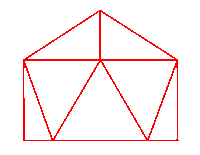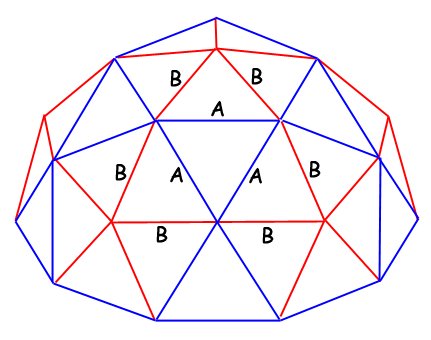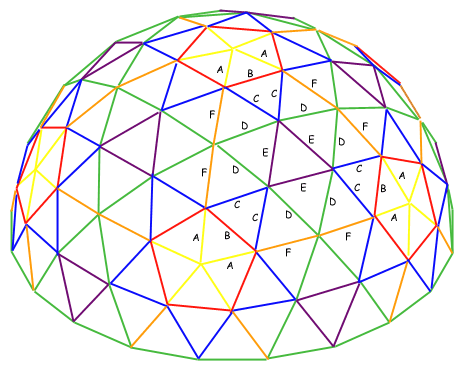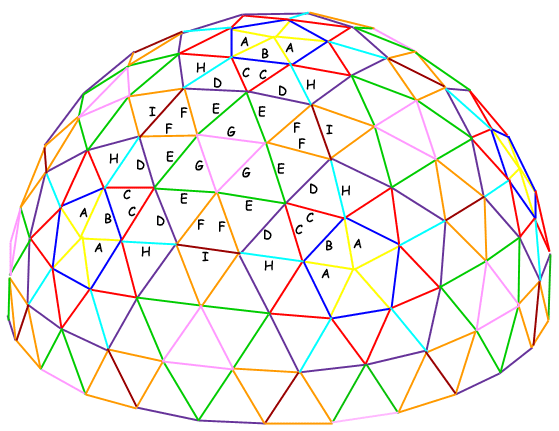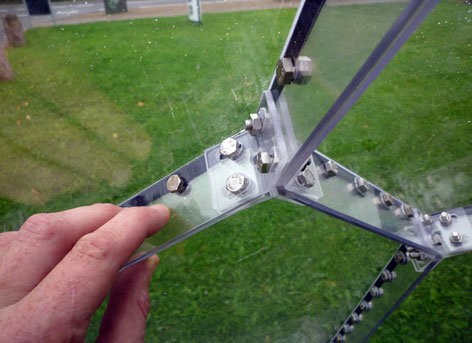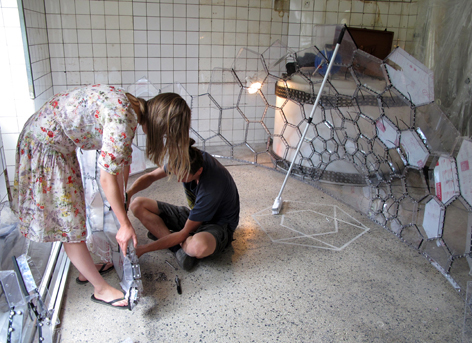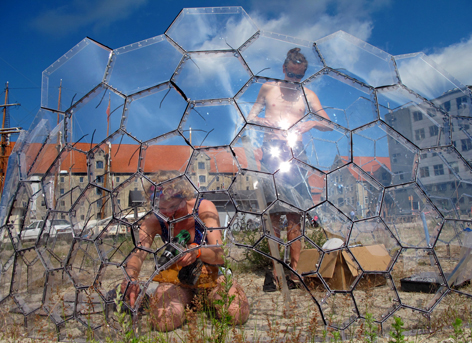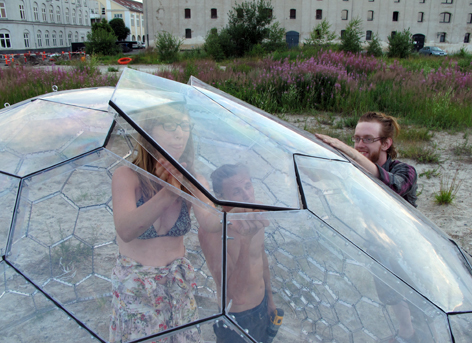
Geodesic domes
I should really build a colorbond shed.
I should really build a starpicket / polypipe shadehouse.
I should really build a romantic garden gazebo.
But then there is this: geodesic domes. Oooh, shiny!
I should build a model using drinking straws and pipe cleaners!
Or use leftover fiberglass rods from a cheap dome tent.
Pros
- Easy to assemble / disassemble.
- Only need 3 lengths of spokes.
Cons
- Looks like a bubblefab Mars habitat to any unappreciative outsider.
- Not all domes sit flat on ground.
- A wooden frame is easier to cover than a pipe frame. A pipe frame is easier to assemble.
- No right angles for traditional windows and doors. (Roof) cladding is complex / tedious.
- No horizontal shelving. No horizontal window sills. It’s a bubble.
Unknowns
- Hub material and construction determines size and strenth for most part – what hubs to use?
- Metal hubs with fingers or PVC hubs with straps or pipe fitting hubs or round screw dish hubs or…?
- 2×4 timber spokes or pipes or broom sticks or… ?
- Domes can have an extra ring past its equator to give it more height.
- Domes can be placed on vertical posts to give it more height.
Geodesic Spheres
Geodesic spheres or Buckminster Fuller’s ‘Bucky Ball’ fullerene molecules (or soccer balls) consist of triangles arranged in a number of connected pentagon and hexagon shapes that when combined make a sphere or dome. Geodesic spheres are made out of twenty hexagons and twelve pentagons, each consisting of respectively 6 or 5 triangles. The shape of a triangle makes it very strong and able to withstand heavy loads.
Types of geodesic domes
Many thanks to http://www.domeclimber.com for providing detailed pictures of the different types of geodesic domes.
1V – Requires 1 lengths of spokes (this illustration is not a perspective view).
2V – Requires 2 lengths of spokes.
3V – Requires 3 lenths of spokes (most popular) – soccerr ball pattern.
4V – Requires 4 lenths of spokes
5V – Requires 5 lenths of spokes
6V – Requires 6 lengths of spokes
More types of domes here: https://simplydifferently.org/Geodesic_Dome_Notes?page=2
Rings
Geodesic domes have a number of distinct horizontal rings of triangles. A 3V geodesic sphere has a total of 9 rings:
- 1 equator ring.
- 4 rings in the top half above the equator ring.
- 4 rings in the bottom half below the equator ring.
A 2V geodesic sphere has a total of 6 rings (3+3).
A 3V geodesic sphere has a total of 9 rings (4+1+4).
A 4V geodesic sphere has a total of 12 rings (6+6).
A 5V geodesic sphere has a total of 15 rings (7+1+7).
Flat base
Many thanks to http://geo-dome.co.uk for explaining this in great detail!
Any geodesic sphere that has an even frequency (2v, 4v, 6v etc) can be divided in two to produce a dome that is exactly half a sphere. But when it comes to odd frequency domes like 3v and 5v it can get a bit tricky.
3 frequency domes are very popular because they look smoother than a 2v dome but don’t have the complexity of a 4v so a lot of people come across the 3v flat base issue.
If a 3v dome were cut in half the dividing line wouldn’t be exactly half a dome, take a look at the diagram below. The blue line shows the line that would divide a sphere exactly in half, this line cuts through all the base triangles and isn’t really a satisfactory way of finishing the bottom of a dome, so what most people do is decide if they need a taller or shorter dome and cut the dome at the red line for a 4/9 dome or the green line to create a 5/9 dome.
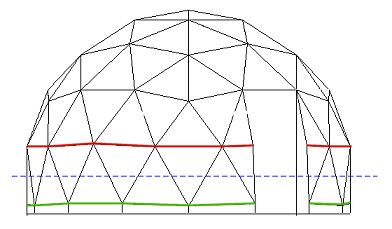
If you erect any dome in height past the halfway point i.e. 5/9 or 6/9 where it starts to resemble a sphere more than a dome, you weaken the structure. The dome will now want to bulge outward when you apply downward pressure at the top of the dome. This is why tall loadbearing cathedral walls have buttresses and brick archways are encased. You may want to consider building a 4/9 dome and use raised vertical posts set in concrete to gain a bit of extra height.
Please visit http://geo-dome.co.uk/article.asp?uname=3vflatbase for more detailed information.
Some more detailed essential information on dome frequency: http://geo-dome.co.uk/article.asp?uname=domefreq
Inspiration
Spaceplates Greenhouse Prototype.
Not a geodesic dome, but very clean and impressive design:
http://anneromme.com/wordpress/spaceplates-greenhouse/
239 plates of CNC cut 3mm thick UV stable(!) polycarbonate panels bolted together with 4800 nuts/bolts. 138m of neoprene acts as a membrane that helps with the curvature of the structure.
I do prefer a circular rather than elliptical footprint. I have come to realize I really like the hexagonal “beehive” look.
Videos
Each 2/4 end is cut at a compound angle of 30 degrees to make hexagons and 4 degrees for curvature. The bottom of the dome sits flat but is angled slightly. At almost 12 inches length struts (300mm) the diameter was around 13 feet (4000mm). The larger dome has 18 inch struts (460mm) and ended up being a 23 feet diameter dome (7000mm). There are 108 hexagons in each structure.
This is a beautiful structure. It is indeed not a true geodesic dome as the author mentions.
Note that it is NOT possible to create a complete sphere made out of hexagons; you need a pentagon here and there to create a curved surface out of hexagons. In the structure in the video the openings are a necessary part of the structure.
I do however like this dome as you have horizontal lines for shelves and window sills / door openings.
There are basically 5 colums, each column 3 tiles wide, that reach for the top of the structure. There are complete horizontal rings of tiles below and above the 5 openings along the side of the structure. There is also an opening in the center of the roof.
This dome is probably not quite as strong as a geodesic dome due to a lack of triangles. If I try to push the tip of a hexagon and a triangle sideways, this is what happens:
The obtuse 6x 120 degrees corners of a hexagon make the shape weak and easier to deform than a (3x 60 degrees acute corners) triangle. One of the edges of a triangle acts as a compression brace or strut resisting deformation. A square or rectangle is weak for the for the same reason. This is why diagonal cross-bracing is required for square shapes at times. Stiffening shapes by applying rigid cladding will improve resistance to deformation. Using shadecloth will not (obviously).
Hubless design
What I don’t like about this method is having to shave off 10-12 degrees of the outside of each triangle with 1 tenth of a degree of accuracy to allow for he correct curvature. But that is only a minor concern.
Hubless design covered in shadecloth?
Usually a shade percentage of 30-50% is ideal for vegetables, while 80-90% is ideal for sheltering people. Most plants will do best with a maximum of 40% – 60% shade. However, when growing some shade loving plants such as orchids and some ferns, 75% or higher maybe needed to get correct light levels.
When using shadecloth you can use hub design – hubless is only if you need it waterproof and tight.
Dome connectors
Nope; this is a dealbreaker for me: domes lose their ‘transparent’ and ‘funky’ look rather quickly:
Links
http://www.domeclimber.com/tmp/2×4-5.8-manual.pdf
http://www.instructables.com/id/Build-a-Geodesic-Dome-Fruit-Cage-With-Hubs/
http://www.n55.dk/manuals/SPACEPLATESG/spaceplatesg.html
http://www.instructables.com/id/Hand-Drawn-Voronoi-Diagrams/
Calculator
http://acidome.ru/lab/calc/#7/12_Cone_3V_R2.5_beams100x50
Hubs
http://www.domerama.com/dome-basics/geodesic-dome-hub-connectors/
The cleanest, simplest and strongest is to use galvanised steel circular half section sticks (or aluminium ‘tent poles’ for smaller domes) and flatten the ends and bend them 10 degrees or so and drill a hole. This removes the need for a hub as you can simply overlap the ends and connect using a single nut and bolt.
http://www.domerama.com/fabricating/making-the-struts/
Using (free) strong and rust-free bamboo combined with pipe fitting hubs is an option.
Using metal plates inserted into slits into timber struts or bolted or screwed to timber struts is another option again.
However, there is always the stacking issue, flex issue and it does not look nice/professional:
So you need a solid hub. Ideally a rigid hub that is angled to the size of the dome you want.
I love what this guy has done:
Construction
Option 1
I would opt for either a 3V 5/9 dome on fillet strips on soil, or a 3V 4/9 dome on posts for increased height whilst requiring only 3 different length of spokes.
I would use 10-12 degrees rectangular half section galvanised spokes with metal slot-in fingers solid hubs.
For a 3V 5/9 geodesic dome you need:
- 30 X “A” (ends bent or cut at 10.04°)
- 55 X “B” (ends bent or cut at 11.64°)
- 80 X “C” (ends bent or cut at11.90°)
Note that this bend angle changes with the size of the spheres; smaller spheres need a larger bend angle.
Option 2
I like the hexagon dome the most, even though perhaps not as strong as a geodesic dome.
I like using timber and cutting a rebate in each hexagon to allow for safety glass panels. $$$.
Not sure how to prevent water from pooling in the recessed window panes…not a good idea.
You could then place leadlighting on the inside; would look great.
I would run some sort of offset rails or standoffs or fancy mechanism to raise or lower shadecloth.
I would strengthen the window openings (welded shape of L shape angled steel for added stiffness?).
Window openings is where the windows should go. Not sure what sort of windows to install.
There are no eaves on a geodesic dome. I don’t like it looking dirty. This is still a problem. I like eaves.
Final thoughts
Just build a romantic gazebo with eaves. Use a a hexagonal roof and vertical posts to support it, like 6 butresses connected at the center roof hub. Make sure there is overhang. Or just build a colorbond shed first, that is more important.

